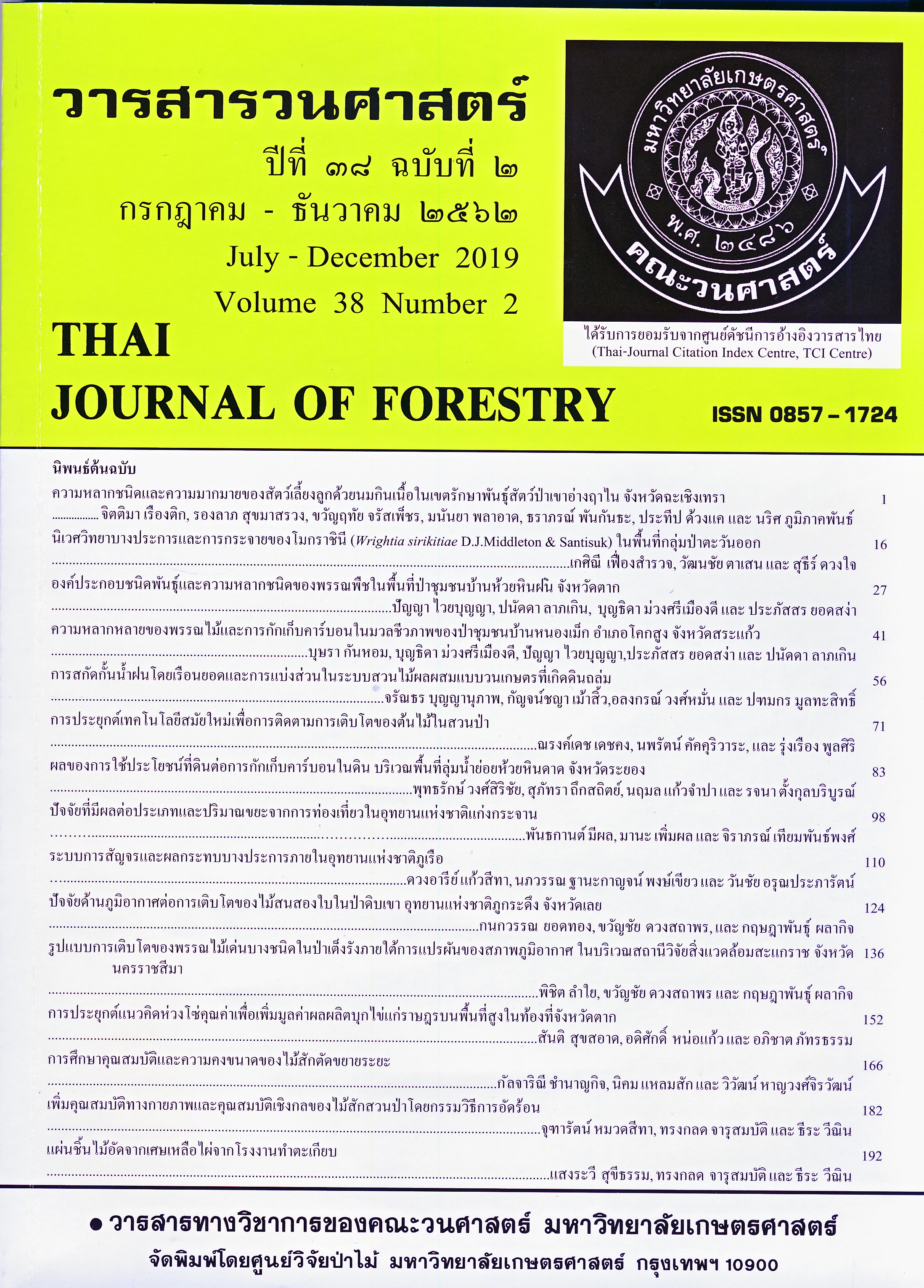เพิ่มคุณสมบัติทางกายภาพและคุณสมบัติเชิงกลของไม้สักสวนป่าโดย กรรมวิธีการอัดร้อน
Main Article Content
บทคัดย่อ
การวิจัยนี้มีวัตถุประสงค์เพื่อศึกษาคุณสมบัติทางกายภาพและคุณสมบัติเชิงกลของไม้สักสวนป่าโดยกรรมวิธีการอัดร้อน โดยมีปัจจัย 3 ปัจจัยคือ อุณหภูมิ (A) 100, 120 และ 150 องศาเซลเซียส อัดร้อนที่ความดัน (B) 1, 2 และ 3 เมกะปาสคาล และใช้เวลา (C) อัดร้อน 5,8 และ 10 นาที จากผลทดสอบพบว่าคุณสมบัติทางกายภาพคือ ค่าเฉลี่ยความถ่วงจำเพาะและความหนาแน่นเพิ่มขึ้น โดยสภาวะที่มีค่ามากที่สุดคือ A150B3C10 มีค่า 0.669 และ 704 กิโลกรัมต่อลูกบาศก์เมตร ตามลำดับ ส่วนคุณสมบัติเชิงกลคือ สภาวะที่มีค่าโมดูลัสแตกหักเฉลี่ยสูงที่สุด คือ A150B2C10 มีค่า 115.36 เมกะปาสคาล , สภาวะที่มีค่าโมดูลัสยืดหยุ่นเฉลี่ยสูงที่สุด คือ A100B1C10 มีค่า 11,856 เมกะปาสคาล, สภาวะที่มีค่าความเค้นอัดขนานเสี้ยนเฉลี่ยสูงที่สุดคือ A150B3C10 มีค่า 50.86 เมกะปาสคาล, สภาวะที่มีค่าความเค้นอัดตั้งฉากเสี้ยนเฉลี่ยสูงสุดคือ A120B2C8 มีค่า 26.78 เมกะปาสคาล, สภาวะที่มีค่าความเค้นเฉือนขนานเสี้ยนเฉลี่ยสูงสุดคือ A120B2C8 มีค่า 16.08 เมกะปาสคาลและ สภาวะที่มีค่าความเหนียวเฉลี่ยสูงสุดคือ A120B2C8 มีค่า 41,365 นิวตัน.มิลลิเมตร เมื่อเปรียบเทียบกับไม้ที่สภาวะควบคุม พบว่าไม้ที่ผ่านกระบวนการอัดร้อนมีค่าคุณสมบัติทางกายภาพและคุณสมบัติเชิงกลมากกว่า และพบว่าต้นทุนในการนำไม้สักสวนป่ามาใช้มีค่าต่ำกว่าไม้สักจากธรรมชาติประมาณร้อยละ 55.27 แสดงให้เห็นว่าไม้ที่ผ่านกระบวนการอัดร้อน เหมาะที่จะนำไปประยุกต์ใช้เป็นส่วนประกอบในด้านต่างๆได้
Downloads
Article Details
ข้าพเจ้าและผู้เขียนร่วม (ถ้ามี) ขอรับรองว่า ต้นฉบับที่เสนอมานี้ยังไม่เคยได้รับการตีพิมพ์และไม่ได้อยู่ในระหว่างกระบวนการพิจารณาตีพิมพ์ลงในวารสารหรือสิ่งตีพิมพ์อื่นใด ข้าพเจ้าและผู้เขียนร่วม (ถ้ามี) ยอมรับหลักเกณฑ์และเงื่อนไขการพิจารณาต้นฉบับ ทั้งยินยอมให้กองบรรณาธิการมีสิทธิ์พิจารณาและตรวจแก้ต้นฉบับได้ตามที่เห็นสมควร พร้อมนี้ขอมอบลิขสิทธิ์ผลงานที่ได้รับการตีพิมพ์ให้แก่วารสารวนศาสตร์ คณะวนศาสตร์ มหาวิทยาลัยเกษตรศาสตร์ กรณีมีการฟ้องร้องเรื่องการละเมิดลิขสิทธิ์เกี่ยวกับภาพ กราฟ ข้อความส่วนใดส่วนหนึ่ง หรือ ข้อคิดเห็นที่ปรากฏในผลงาน ให้เป็นความรับผิดชอบของข้าพเจ้าและผู้เขียนร่วม (ถ้ามี) แต่เพียงฝ่ายเดียว และหากข้าพเจ้าและผู้เขียนร่วม (ถ้ามี) ประสงค์ถอนบทความในระหว่างกระบวนการพิจารณาของทางวารสาร ข้าพเจ้าและผู้เขียนร่วม (ถ้ามี) ยินดีรับผิดชอบค่าใช้จ่ายทั้งหมดที่เกิดขึ้นในกระบวนการพิจารณาบทความนั้น”
เอกสารอ้างอิง
British Standard 373:1957. 1957. Methods of Testing Small Clear Specimens of Timber. British Standards Institution, UK.
Candan, Z., S. Korkut and O. Unsal. 2013. Thermally compressed poplar wood (TCW): Physical and mechanical properties. DrvnaIndustrija 64(2): 107-111.
CFC/ITTO. 2009. Study on Utilization of Plantation Teak Pre-project: Handbook on Properties of Plantation Teak in Myanmar. CFC/ITTO 73 FT PPD 68/03 Rev. 2 (I). Myanmar.
Dinwoodie, J.M. 2000. Timber: Its Nature and Behaviour. 2nd ed. Routledge, London.
Forest Industry Organization. 2017. Pricing table of plantation teak lumber. Available Source: http://www.northfio.com /web/phocadownload/wood/pricelumber2560.pdf, November 24, 2018. (in Thai)
Hill, C.A.S. 2006. Wood Modification: Chemical, Thermal and Other Processes. John Wiley & Sons Ltd., The Atrium, Southern Gate, Chichester, West Sussex.
Inwiset, S. 2014. Growth and yield of teak (Tectona grandis Linn.) under different regeneration methods in khun mae khummee plantation, Phrae province. Thai Journal of Forestry 33(2): 52-60.
Josue, J. and Z. Imiyabir. 2011. Anatomical Features, Quality and Mechanical Properties of 15-Years-Old Tectona grandis (TEAK) Planted in Sabah. ITTO project on improving utilization and value adding of plantation timbers from sustainable sources in Malaysia project no. PD 306/04 (1). Forest Research Institute Malaysia, Selangor Darul Ehsan.
Kim, G.H., K.E. Yun and J.J. Kim. 1998. Effect of heat treatment on the decay resistance and the bending properties of radiata pine sapwood. Material und Organismen 32(2): 101–108.
Ladrach, W. 2009. Management of Teak Plantations for Solid Wood Products. ISTF News Special Report. 25 p.
Seviset, S., T. Piromgran, U. Saributr, R. Porncharoen, K. Raerai and S. Charoensettasilp. 2017. Mechanical property of 9 years old thinning of teak plantation in Thailand. MATEC Web of Conferences 95: 03004.


